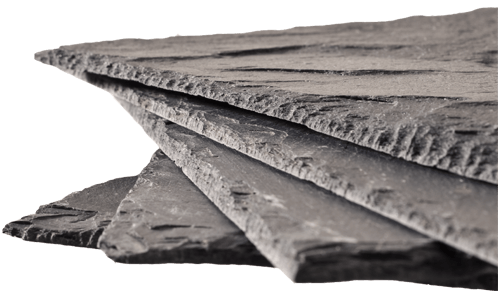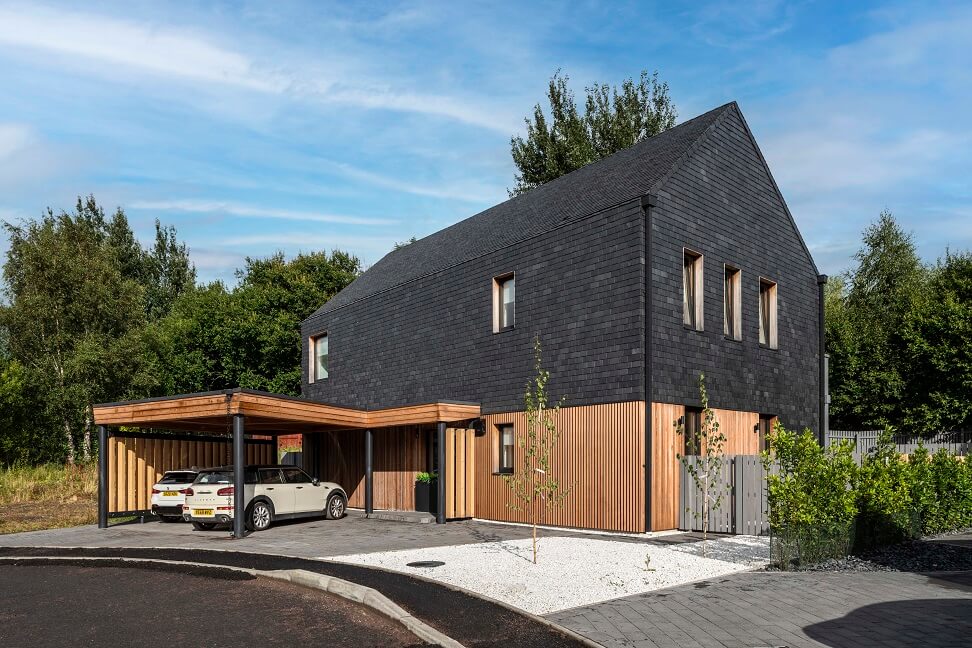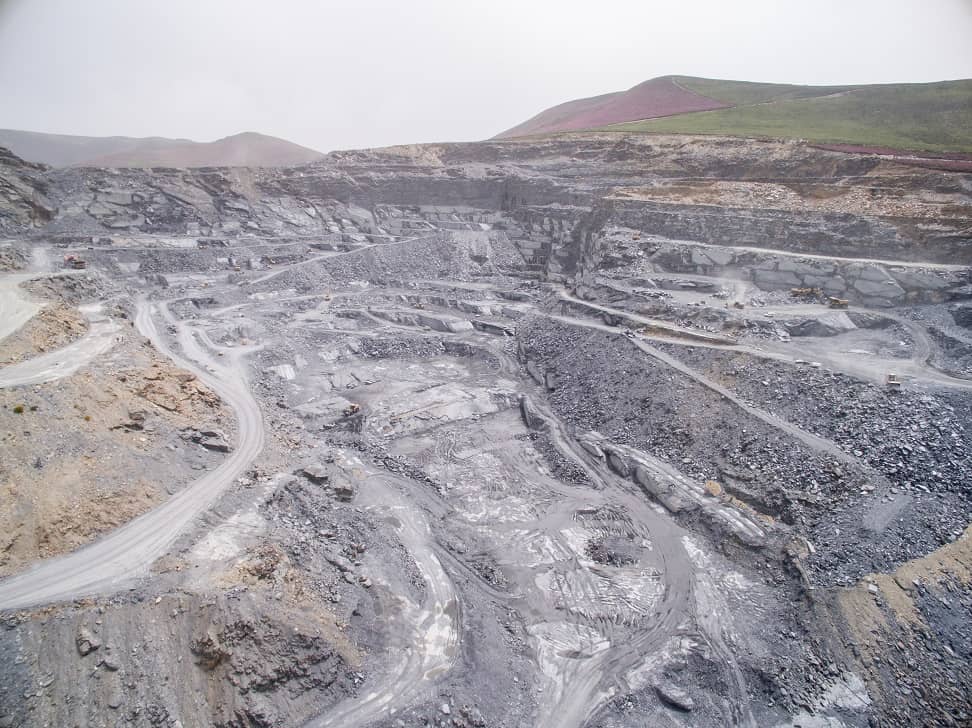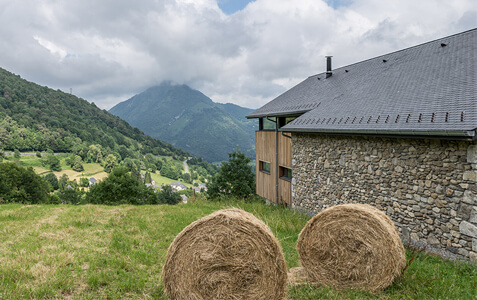Slate is a fine-grained metamorphic rock derived mainly from mudstone and shale.
What is slate?
Is believed that the word “slate” comes from the Old French word scalar meaning fragment, from the verb slater, to shatter.
Slate is derived from fine-grained sediments such as mud or occasionally volcanic ash laid down millions of years ago in layers known as bedding. As the pile of sediments thickened, the original open structure of the mud was compacted into a mudstone or shale.
These rocks are easily split on the bedding planes and are referred to as flagstones. However, for a slate to form, subsequent intense geological forces associated with mountain building are required, during which the minerals present in the original mudstone are metamorphosed.
Some minerals, such as quartz grains, are flattened and stretched, while clay minerals are recrystallised as platy minerals: white mica and chlorite. The quartz minerals give the slate strength and durability, while the platy minerals form cleavage planes, which do not correspond to the bedding planes, but which allow the rock to be split into much thinner slabs suitable as roofing material. Differences in the composition of the original mudstone and the degree of metamorphism affect the quality of the slates thus produced.

The geology of slate
- Slate is a metamorphic rock of sedimentary origin.
- It dates from the Ordovician period (550 million years ago)
- Is mainly composed of quartz, sericite and minerals of the chlorite group.
- Has been used as a construction material since the ancient Egyptians.
- Its colour depends on the mineral structure and size of the mineral grains that define its composition.
Uses of Slate
Slate has a long tradition as a construction material. Slate is a natural, aesthetically pleasing stone. Its strength and outstanding resilience make it one of the most durable and versatile roofing materials. The beauty of slate lies in the fact that it is a natural resource that requires little alteration from its natural form and offers a long lasting, pollutant resistant, fireproof, waterproof material with a warmth and elegance which places it in a league of its own.
Slate is mainly used for:

What is the age of slate?
The age of the slate stone varies depending on the regional geology.
For example in Scotland, Ballachulish slate was formed from sediments laid down approximately 700 million years ago and was metamorphosed 500 million years ago, while Spanish slate from the Orense area was formed from muds laid down over 450 million years ago and was metamorphosed 300 – 350 million years ago.
Production process and exploitation areas
There are two natural slate extraction methods: open quarries and underground mines. In general, natural slate is surface quarried.
Here you can see an image of our Quarry 10 in Spain, called Las Arcas, which is the World’s largest slate quarry.

In the slate production process, there are no chemicals or additional treatments used, making it a 100% natural and an ecological material.
The most important deposits currently extracted are found in the Hercynian Mountain range that runs through Europe.
Spain is the country with the largest reserves of tectonic slate in the world. It is estimated that approximately 90% of the natural slate used in construction is obtained from Spain. In the northern region of Galicia and neighbouring provinces is where the largest number of mining operations are located.
These deposits are found on slate formations from the middle and upper Ordovician (from 485.4 million years ago to 443.8 million years ago) The most important are the geological structures of the Truchas Syncline (Orense and León) and the Caurel Syncline (Lugo and León).
Other countries with slate outcrops are:
- United Kingdom: Wales (Penrhyn Quarry).
- China.
- Brazil: 95% comes from the state of Minas Gerais.
- United States: Terranova, Vermont, New York (Slate Valley) and Virginia.
Slate characteristics
Slate as a roofing product is today unbeatable, from both a performance perspective and lasting aesthetics.
It is a natural material extracted directly from deposits with the utmost care to respect its properties as much as possible.
The only process that the raw material goes through is cutting which necessary to adapt it to the commercial format. It does not need any further treatment.

The colour of slate depends on its mineralogical composition and its high-performance comes from its properties, among which waterproofing, resistance, durability and versatility stand out.
History of natural slate in Scotland
Slate has been used as a roofing material throughout scotland since The middle ages. Quarries were located in several areas, of which the Most important were:
- Easdale and the surrounding Slate Islands south of Oban.
- Ballachulish, near the southern end of the Great Glen.
- Highland Boundary: a series of quarries on a line from Arran to Dunkeld.
Some of the earliest references are to Easdale, from which slate was sent to St Andrews in 1197, and to Glasgow to roof the cathedral also in the 12th century. Reliable records began in 1745 when the Earl of Breadalbane and others
established the Marble and Slate Co of Netherlorn to extract slate from Easdale Island.
As demand increased during the 18th and 19th centuries, the company expanded to neighbouring islands. Slates
were transported by sea around the north coast to all the major towns on the east coast and through the Crinan
Canal to Glasgow and other west coast centres.
Ballachulish is the best known Scottish slate, both in terms of quality and quantity.
Production began at the end of the 17th century and expanded rapidly to overtake the Slate Islands in the 1860s.
The quarries were ideally located close to Loch Leven, which enabled slates to be transported by sea around Scotland.
Highland Boundary slate was produced from a series of quarries just north of the Highland Boundary Fault of which Aberfoyle is the best known.
They are grouped together because of similarities in their geology, but have very different histories.
Proximity to the coast was initially the most important factor limiting production; for example, slates from the island of Bute were reputedly used in the 15th century and from Arran in the 18th century.
With improved communications in the 19th century, sea transport was no longer essential and inland quarries such as Aberfoyle came into their own.
The rise and fall of the Scottish slate industry mirrored that in other parts of Britain. Starting slowly, it reached its zenith around 1900, producing 25-30 million slates per annum.
However the beginning of the 20th century was marked by a depression in the building trade, compounded by a shortage of manpower during two World Wars. While the Welsh and English quarries survived, the Scottish industry could not compete with tiles and imported slate. The Ballachulish quarries closed in 1955 and the remaining quarries in the 1960s.

